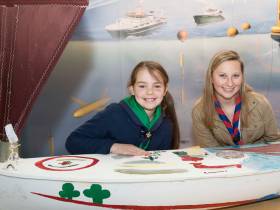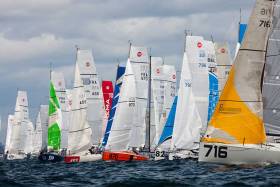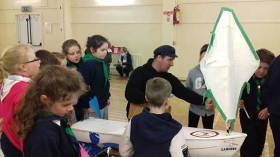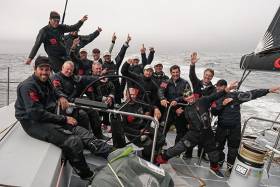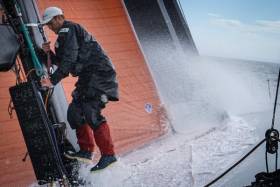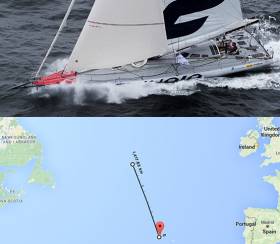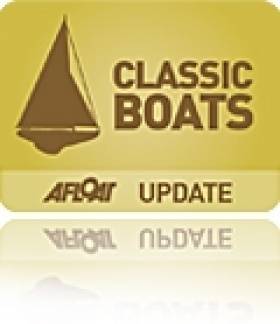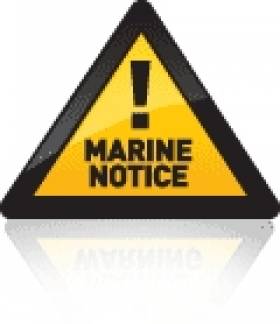Displaying items by tag: Transatlantic
Transatlantic Friendship Over Unmanned US Sailboat
#Lancer - An American high school student this week made the trip across the Atlantic to meet the Galway schoolgirl who found her marine science project mini-yacht last year.
Kaitlyn Dow from Waterford High School in Connecticut met eight-year-old Méabh Ní Ghionnáin for the first time at the Marine Institute in Galway for the official handover of the unmanned Lancer sailboat, which is set to be relaunched from the RV Celtic Explorer in the Atlantic later this year.
The 1.5m boat provided by Educational Passages was used as part of Kaitlyn's year-long research project studying wind and currents in the ocean.
Fitted with a GPS transmitter, the boat was released in May 2016 by NOAA ship Neil Armstrong off the coast of Cape Cod and successfully crossed the Atlantic.
In September, Kaitlyn made an appeal to Afloat.ie readers to keep a look-out for Lancer as it was tracked as far as Galway Bay.
And when it was eventually washed up in Connemara on 20 September, Méabh was the first to find it after following its GSP signal to a spot near her home in Lettermore.
Marine Institute chief executive Dr Peter Heffernan congratulated Méabh and Kaitlyn on their endeavours, adding: "We are thrilled to be involved with the continued voyage of the Lancer sailboat where it will be launched from the research vessel RV Celtic Explorer during its up and coming transatlantic expedition in April.
"This story is a wonderful example of both science literacy and citizen engagement with the oceans – themes which are a priority for the Atlantic Ocean Research Alliance between Canada, the EU and USA.
“Seeing new friendships formed across the Atlantic at an early age highlights the value of international partnerships that are essential for sharing marine science.”
Dr Heffernan added: “With the Atlantic being the second largest ocean in the world, it is important to increase our awareness of the value, opportunities and societal benefits the ocean provides us.”
Michael O'Connor, Kaitlyn's science teacher from Waterford High School, also made the trip to Ireland wit her and her family.
"I am thrilled to see this project to the next stage bringing Méabh and Kaitlyn together,” he said. “Although this started as a science project, the social connections and the sea that binds them are just as important as the data collected.
"Kaitlyn learned to design a study from the ground up, figure out how to fund it, make the social and professional connections to further the project and foster an international dialog about the ocean.
“She has a love for sailing and turned that love into a science project with great social impact and a great story. She will carry that combined social service and love of the sea to the Coast Guard Academy next year for college.”
Lancer was repaired by Ciaran Oliver and James Rattigan from Port of Galway Sea Scouts, as previously reported on Afloat.ie.
The Sea Scouts recently visited the RV Celtic Explorer with Méabh and will also be attending a seashore safari with Galway Atlantaquaria and the Explorers Education Programme team later this month.
Mini Transat: Fully Booked, One Irish Adventure Sailor in 84–Boat Fleet
Solo Sailor Tom Dolan from County Meath has booked his place in October's Mini–Transat Race from La Rochelle to Martinique.
The sole Irish entry was in Dublin last night to talk about his exploits at Poolbeg Yacht and Boat Club. This will be Dolan's second Mini–adventure having successfully competed in 2015.
For this 2017 edition of the race, organised by Collectif Rochelais pour la Mini Transat, the race will host a full contingent as the number of applicants signed up for the adventure already exceeds the 84 places available. Download the full entry list below.
- The Mini Transat 2017 will set sail from La Rochelle
- Las Palmas de Gran Canaria and Le Marin (Martinique) the stopover and finish venues
- 84 competitors expected on the start line on 1 October 2017
Forty years on from its first edition, the Mini Transat remains on the crest of the wave. A maiden voyage for some, a stepping stone to further sporting challenges for others, the Mini Transat holds a very special place in the world of offshore racing. In an era of new technologies and intensive communication, it is still the only event where each racer is pitted solely against themselves during a transatlantic crossing. No contact with land, no other link to the outside world than a single VHF radio, at times the Mini Transat is a voyage into solitude.
Boats: minimum length, maximum speed
With an overall length of 6.50m and a sail area pushed to the extreme at times, the Minis are incredibly seaworthy boats. Subjected to rather draconian righting tests and equipped with reserve buoyancy making them unsinkable, the boats are capable of posting amazing performances in downwind conditions… most often to the detriment of comfort, which is rudimentary to say the least. In the Class Mini, racers can choose between prototypes and production boats from yards. The prototypes are genuine laboratories, which frequently foreshadow the major architectural trends, whilst the production boats tend to be more somewhat tempered by design.
Racers: from the amateur to the future greats of offshore racing
There are countless sailors of renown who have made their debut in the Mini Transat. From Jean-Luc Van Den Heede to Loïck Peyron and Thomas Coville, Isabelle Autissier and Sam Davies, a number of offshore racing stars have done the rounds on a Mini. However, the Mini Transat is also a lifelong dream for a number of amateur racers who, in a bid to compete in this extraordinary adventure, sacrifice work and family to devote themselves to their consuming passion. Nobody comes back from the Mini Transat completely unchanged. This year, there will be 84 solo sailors, 10 of whom are women! The Mini Transat is also the most international of offshore races with no fewer than 15 nationalities scheduled to take the start.
The course: from La Rochelle to the West Indies via the South face
Two legs are offered to make Martinique from Europe’s Atlantic coasts. The leg from La Rochelle to Las Palmas de Gran Canaria is a perfect introduction to proceedings before taking the big transatlantic leap. The Bay of Biscay can be tricky to negotiate in autumn while the dreaded rounding of Cape Finisterre on the north-west tip of Spain marks a kind of prequel to the descent along the coast of Portugal. Statistically, this section involves downwind conditions, often coloured by strong winds and heavy seas. Making landfall in the Canaries requires finesse and highly developed strategic know-how.
The second leg will set sail on 1 November. Most often carried along by the trade wind, the solo sailors set off on what tends to be a little over two weeks at sea on average. At this point, there’s no way out: en route to the West Indies, there are no ports of call. The sailors have to rely entirely upon themselves to make Martinique, where they’ll enjoy a well-deserved Ti Punch cocktail to celebrate their accomplishments since embarking on the Mini adventure.
Five–Foot American Transatlantic Yacht Repaired By Connemara Sea Scouts
When Kaitlyn Dow of Waterford High School in Connecticut put a shout–out through Afloat.ie last September for people to look out for her unmanned yacht off the Galway coast, little did she realise she would be travelling across the Atlantic to meet those finders and be reunited with her school project.
The 5ft mini–sailboat, The Lancer, was washed up in Connemara on September 20 last year. Sent by Dow of Waterford High School in Connecticut, it travelled all the way across the Atlantic, and was picked up by Méabh Ní Ghionnáin (aged 8) on Garumna Island, Co. Galway.
Since then, the Connemara Sea Scouts, who are affiliated with the ISA’s Galway Sea Scouts, have patched up The Lancer and are preparing to send it on another voyage.
Visitors from Waterford High School are due in Connemara in late February – so more updates to come.
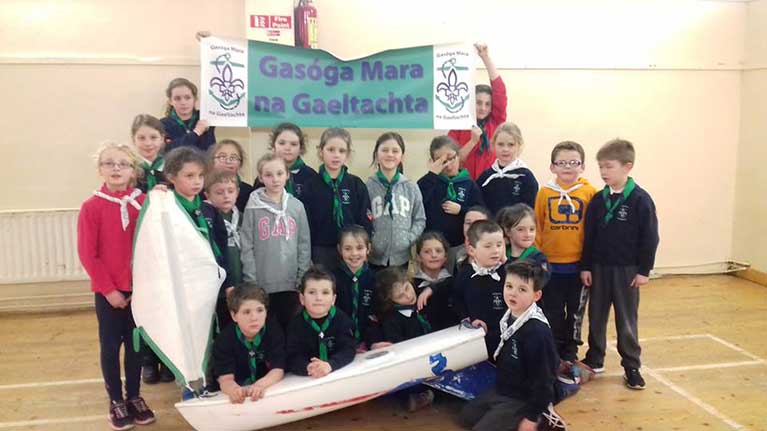 The Connemara Sea Scouts with the American mini yacht
The Connemara Sea Scouts with the American mini yacht
Comanche Breaks Monohull Transatlantic Record
At 12:19:41s GMT today, Thursday 28th July, Comanche passed Lizard Point (UK) to complete the 2,880 nautical miles from West to East across the Atlantic and smashed the monohull transatlantic record*. This illustrious record had been held by Mari Cha IV since 2003 and stood at 6 days 17 hours 52 minutes and 39 seconds. The talented crew of world class sailors beat the previous record by 1 day, 3 hours 31 minutes 14 seconds in a total elapsed time of 5 days, 14 hours, 21 minutes 25 seconds at an average speed of 21.44 knots.
Comanche’s owner Jim Clark said: “Comanche was built to break ocean records and the guys have once again powered our fantastic fat-bottomed girl to another title. I am so proud of the entire team and everyone involved in the entire program from top to bottom, the best in world, getting the best out of Comanche. Perfect harmony, and Kristy and I are over the moon.”
The experienced team left New York (USA) on Friday evening July 22nd at 20:58 UTC and headed East aiming for the South West tip of England.
Comanche had been on standby for a number of weeks waiting for optimum conditions to slingshot across the Atlantic, managing a fluid rota of over 30 world class sailors on standby over a three month period, primed to be ready at a moment’s notice. On Thursday the team were moved to a ‘green’ as world class navigator Stan Honey alongside skipper Ken Read, agreed that this was the time to go.
With Comanche skipper Ken Read committed to TV commentating at the Louis Vuitton America’s Cup World Series in England, the world class crew was led by team leaders Casey Smith, Tony Mutter, Richard Clarke and Navigator Stan Honey. Due to other commitments, Comanche was also missing regular crewmen such as Kelvin Harrap, Warwick Fluery, Jimmy Spithill and Ryan Godfrey (see full crew list below).
Ken Read concluded: “This latest record is testament to Jim and Kristy’s vision. This is the culmination of six years of hard work and a huge team of experts offshore and onshore all working as one. I never had any doubt this crew would deliver the goods – the boat was in perfect condition and the only thing that would scupper the record would be Mother Nature. Luckily she didn’t throw a spanner in the works and this team have once again proven why they are some of the best in the business.”
The weather window promised fast conditions with strong winds, great angles and flat seas all the way to Europe. And overall it delivered, enabling the team to tear across the Atlantic in record time, using only manual powered winches and hydraulics. But it wasn’t all plain sailing, the crew encountered some cold, foggy and squally weather with some nail biting lighter patches that kept them all guessing and hoping that they could stay in the same weather system for the duration of the crossing. They also encountered the danger of ice ensuring the team remained on high alert making the trip, and the record, even more of an achievement. Stan Honey used all his experience to identify this unique weather window, once again showing his colours as the best navigator in offshore racing.
Quotes from the boat:
Casey Smith: "What a boat! Now we have got the 24 hours record, the Sydney Hobart, and now the transatlantic. What a boat! Awesome!"
Stan Honey: "There are only about two weather windows a year where a monohull can make it all the way across the Atlantic in one system, and we found one of them. Beating this record by more than a day is above my expectations and I am delighted."
Tony Mutter: "To achieve something like that, it is important to be fast and reliable. I am happy for all the people involved in this project from the very beginning up to now."
Richard Clarke: "Delighted. Awesome trip, I have been loving every minute of it. Now I am proud of the accomplishment for the boat and for the team."
Pablo Arrarte: "I think this is something big. I don’t think anyone will beat it in the near future."
Shannon Falcone: "This was sort of the Everest of the whole Comanche program, and I am both proud and delighted to be part of it."
The record continues to illustrate Comanche’s pedigree since the Supermaxi was launched in October 2013. Comanche has taken line honors in all races but one entered and currently holds four ocean records.
*Record still to be ratified by the WSSC (World Speed Sailing Council)
With 1,548 nautical miles left to sail to the finish of the Transatlantic record (as of 08:30 GMT today) at Lizard Point, UK, Comanche remains on course to break Mari Cha IV’s 2003 record.
Stan Honey, Comanche navigator, noted this morning: Chilly here. Set the A-3 Gennaker to go deeper. Very flat water. Smooth sailing. Not much wind down low near the cold water. Visibility 10 meters. Keeping careful radar watch.
Boat Captain, Casey Smith also sent an update from onboard this morning: “Everyone on board is doing great. Tony, Richard and Dirk are all over the sail selections and we are managing to keep the boat going fast with fresh drivers. We are doing four on, four off watches and everyone is getting good rest. The boat is in great shape with no issues to report. Looks like we have a period of lighter air to navigate over the next 24 to 36 hours, which should give us a good chance to have a full check over. Water ingress is very low. The new bow drains are doing the trick with only a couple of buckets pulled out of up front in the first 36 hours.
The Offshore Dodger will never come off again if the crew has their way - such a game changer. Hatches open the whole time and the pit area of the boat so much safer during high-speed maneuvers. We hit one log with the keel and snapped it in two but it missed the rudders thank goodness. Now we just need to miss the ice and we should be in great shape.
Everyone is great. Life is good. Go the Comanche.”
Meanwhile, watching the record run from the TV compound at the Louis Vuitton America’s Cup World Series in Portsmouth, Comanche’s skipper Ken Read believes the next 24 hours are crucial for two reasons: “Firstly, Comanche is crossing a bit of ridge and this will bring some of the lightest air they will see on this whole trip. And if you aren't careful you can get quite bogged down in it and miss the window. When you do these record attempts you sort of ‘hop on the train’ and hope that the train takes you all the way to the next station. They need to get through this next light air zone to get back on the train again and rip it across the ocean.
“Secondly, they are right in the possible projected ice zone literally with zero visability – I don’t need to tell anyone that carbon fibre and ice do not like each other and it doesn’t go well if they meet. The guys are very aware; it’s cold and very foggy. They have a great radar system on board the boat, which they are quite confident in. I have talked to them a lot and in fact, I think they are pretty sick of me by now but I now know how hard it is to watch these things from dry land, especially when you see the fantastic pictures of glamour sailing.”
Comanche’s owners, Jim Clark and Kristy Hinze-Clark, are naturally following the record run extremely carefully. As Ken Read concludes: “It’s funny, Jim and I have both also become armchair navigators during our many text message banters, discussing whether the best navigator in the world [Stan] is actually doing the right thing. But I think at the end of the day he and I are going to give way to Mr Honey. Not only that, Ken Campbell and Commanders weather are supporting Stan to help make sure he is making all the right decisions. Stan has a programme set up from the boat whereby on the half hour it pings all the key information off the boat e.g. latitude, longitude, boat speed, wind speed and wind direction, to several of us including Ken Campbell so he is monitoring it very carefully and making sure that a tired Stan Honey is still paying attention. This is a different sort of situation for all of us (other than maybe Stan) as in a race you can’t have any outside assistance but here you can have people making sure that all of the sudden a tired mind doesn’t miss anything. Ken has been awesome up to now, watching over things and offering suggestions to help support Stan out there. And also looking at some high altitude weather that could affect things - so the combination means Comanche has the best chance, so let’s see what the next little phase brings.”
To follow the progress of Comanche, please visit here
Abandoned IMOCA 60 Yacht. It's Red & White & 60ft Long. Ireland Please Keep A Look Out!
British sailor Richard Tolkien (61), one of the competitors in the race from Plymouth to New York, abandoned his yacht '44' and boarded the Cargo Ship ANTON TOPIC on Friday. Tolkein, who sustained head injuries in the abandonment, say it is his intention to recover the boat that is currently believed to be in a location nearly nine hundred miles north west of the Azores.
“I had to leave the boat which has a tracker on it – not an easy situation - and I hope to rescue the boat he said after the ordeal.
Locating the boat will not be easy according to Kinsale based Marcus Hutchinson who co-ordinated and recovered another abandoned IMOCA yacht last January. Hutchinson and a team set out from West Cork and rescued the SMA sponsored IMOCA Yacht last January.
Hutchinson told Afloat.ie he wasn't sure if the boat would make it into Irish waters: 'it is a lot further south and west and the weather is a bit different at this time of year so would take a lot longer. Also, I think the tracker, which is yellow brick, won't last for more than a couple of weeks', he said.
The movement of the yacht depends on the rig set up and what sails are still flying. It is unlikely to reach Ireland on the basis of current alone as it’s too far south and as it moves east there is a southerly element to the ocean current so it will probably end up moving south on the Canary current.
However, like SMA, the sail set up could promote sailing and more than counteract current if there is a south westerly and if it is more wind influenced it could “sail” in a north easterly direction – if it did this at 5 knots, it would be 300 hours or around two weeks before it got to the Irish coast.
French SMA Yacht Recovered & Brought to Crookhaven
An 60–foot round the world French racing yacht is berthed in Crookhaven Bay in County Cork this morning having been abandoned mid–Atlantic three weeks ago and brought to the Irish harbour by a recovery team that included Kinsale's Marcus Hutchinson.
Since Paul Meilhat was airlifted off SMA on 15th December, during the transatlantic Race in which Ireland's Enda O'Coineen finished third, the 60-footer has drifted up from the Azores to Ireland over the past twenty days, during which the SMA team has attempted several recovery operations, in spite of some horrendous weather.
On 5th January, the boat was finally recovered 100 miles off the coast of Ireland. SMA is now safe in Crookhaven Bay in SW Ireland. On board, the boat captain, Marc Liardet and his team are trying to sort the boat out. Their goal is to get her back to France and to Port La Forêt as soon as the weather allows.
In early January, two operations were set up at the same time with Mer Agitee, the owner of the monohull and the boat's insurers, Pantaenius. On 4th January, on a boat was chartered by the insurance company with the ocean racer, Adrien Hardy on board. He managed to get aboard SMA, in some very rough conditions in 40 knots of wind and 20-foot high waves, while the Mer Agitee shorte team joined in aboard an Irish tug.
As the Mer Agitee predicted, after following the progress of SMA thanks to her Argos beacon, following on from the operation to rescue Paul Meilhat, the mast was still in place.
The recovery team in Ireland:
Marcus Hutchinson, Marc Liardet, Anne Liardet, Antoine Brunel and Damien Guillou.
Three Irish Boats Ready For ARC Transatlantic Rally
The 30th ARC fleet leaves on Sunday, and here in Las Palmas the atmosphere is keen with anticipation writes Irish Transatlantic debutante Frank Quinn.
Crossing for the first time, I'm on a fine UK-registered Nordship 43 DS called Nina, owned by one-time Dublin resident Stephen Cooke. We're six in all: judging by the provisions we've just stowed, it will be a busy schedule of eating and snacking, occasionally interspersed with sailing.
There are more than 200 boats here counting down to the start. It's a well-run event, with daily seminars and a social programme. The chat in the bars is around prep, prep and more prep. T-shirted Raymarine techies are kept well-busy, and the chandler down the road has started a number system for serving.
Just three Irish boats are registered: Alpaire, a Hallberg-Rassy 48 skippered by Des Cummins; Crackerjack, Colum O'Sullivan's Oyster 53; and BAM, Conor Fogerty's HYC-based Sun Fast 3600. Among the smallest boats in the racing fleet, His target is 14-16 days to St Lucia.
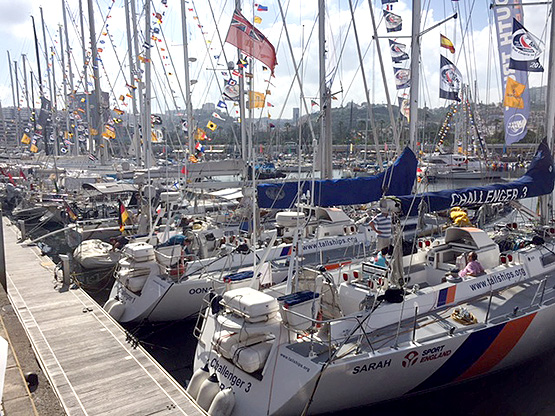 A section of the ARC fleet in Las Palmas
A section of the ARC fleet in Las Palmas
Contrary to the popular plan of 'heading south until the butter melts', he intends to head west early. "We plan to ride as far as possible until it gets light," he says, "then head down to pick up the trades." Downwind rig is an A2 (tricolour!), A5 and a Code Zero. Crewing are Louis Bell, Robert Cooper, and Daragh Heagney.
It's Conor's 29th transatlantic. Once in St Lucia the plan is to compete in the Caribbean 600, then return to prep for the solo Fastnet and the Round Ireland two–hander. He points out One and Only, a Polish-registered sistership. "It will be a good race," he says.
Back to Nina, where the creature comforts include water maker, generator and a fine bank of electronics. As I type, vegetables and fruit are arriving so it's time to get busy.
Signing off... you can track Nina and all the Irish boats on the ARC site here
Irish sailor and artist Pete Hogan spent a few days in Las Palmas as the fleet was assembling before departure to Saint Lucia and you can see his watercolours here
In late June, one of sailing's most celebrated yachts will attempt to retrace the steps of her first, and most significant, victory. The 52-foot yawl Dorade, owned by Pam Levy and Matt Brooks (Tiburon, Calif.), will join 40 other boats competing in the Transatlantic Race 2015, which starts off Newport, R.I., and finishes off the southwestern coast of England. The race is organized by the Royal Yacht Squadron, the New York Yacht Club, the Royal Ocean Racing Club and the Storm Trysail Club.
Dorade, the seventh design from the Sparkman & Stephens design shop, was barely a year old when Olin and Rod Stephens and a crew of five sailors, including their father, started the 1931 Transatlantic Race off Newport, R.I., bound for Plymouth, England, 2,800 miles away. The trip took just over 17 days. Dorade was the first boat to finish and the race's overall champion on corrected time.
For the Stephens brothers, it was a transformative moment: in the coming years, they would each take on primary roles in the development of the sport. Dorade would make her own wake as well, stringing together an impressive, unparalleled for the time, series of victories on the East and West Coasts of the United States and in Europe.
After a series of significant re-fits, the boat was returned to original condition a few years ago by Levy and Brooks. Perfect for installation in a museum, many said, or for civilized day racing on the classic yacht circuit. But Levy and Brooks had other plans, namely to take the grand dame of ocean racing and repeat all of the races it won in the 1930s, including the Transatlantic Race, Newport Bermuda, Transpac and Rolex Fastnet.
"Everyone said we were proposing something that wasn't even in the realm of possibility," says Brooks of Dorade's four-race "Return to Blue Water" campaign. "Now we're coming up to the last two races—the Transatlantic Race 2015 and the Rolex Fastnet Race—and no one is questioning that the boat can do this." (Two years ago, Dorade won overall, corrected-time honors in the Transpac Race, beating a host of the latest carbon-fiber rockets; in the 2014 Newport Bermuda Race, she took first in her class under IRC.)
"Olin and Rod designed one hell of a boat," says Brooks. "I haven't met anyone who has sailed on her who doesn't learn to love her and trust her. She's very strong, very dependable; she just needs to be treated right. With wood boats, you're always in refit mode. But we're racing and sailing this boat 10,000 miles a year and she absolutely responds to that."
Winning silver with this historic yacht requires a comprehensive commitment. Brooks, Levy and their team are constantly maintaining and refining the yacht. This past winter, says Brooks, getting the bottom as smooth as possible and improving sail design were two areas of focus. Sailing the boat also requires a specific touch.
"If you are trying to muscle the boat into submission at the helm it is never going to happen," says Levy. "It will win. Having a balanced helm is critical."
For the Transatlantic Race 2015, Brooks and Levy have set as their first goal to beat the 17 days, one hour and 14 minutes it took Dorade to sail the course in 1931. Modern technology, including synthetic sail fabric, should give this year's team an edge; however, the course in 2015 is likely to be quite a bit longer than it was in 1931 due to an extreme number of icebergs in the Grand Banks of Newfoundland. The fleet will be required to sail east for a while before turning north for the Great Circle Route, which takes advantage of the earth's slightly oval shape to shave critical miles off the passage between the United States and Europe.
Whether or not they can match the boat's pace in 1931, Brooks and Levy couldn't be more excited about the prospect of this legendary yacht coming full circle to its first significant accomplishment.
"Of all the races we've done, the Transatlantic Race is the one that makes our heart go pitter patter, because it was Olin and Rod's first big victory, and it's what launched them in business in yacht design," says Levy. "We know from talking to Olin's family and from what he has written that he had a real affection for the boat. It gives us a lot of pleasure to do well with her."
#HiberniaExpress – The Department of Transport, Tourism and Sport has been advised that TE SubCom, on behalf of Hibernia Express, is scheduled to carry out a Route Clearance Operation and a Pre Lay Grapnel Run along the Hibernia Express cable route off the South of Ireland and Bristol Channel. The department has issued a marine notice to all Shipowners, Fishing Vessel Owners, Agents, Shipmasters, Skippers, Fishermen, Yachtsmen and Seafarers.
TE SubCom is prime contractor to Hibernia Express to supply and install a trans-Atlantic subsea fiber optic telecommunications cable system designated the "Hibernia Express Cable System" between Halifax (Nova Scotia), Cork (Ireland) and Brean (United Kingdom). A schematic representation of the whole of the route of the cable is shown below, as well as the start and end points of the route position listings.
Position Listing for Hibernia Express from offshore Cork, Ireland to Brean UK:-
Start Point (WGS-84) 51˚ 15.0760" N 008˚ 39.2900" W
End Point 51˚ 17.1808" N 003˚ 00.8175" W
Position Listing for Hibernia Express from the Continental Shelf to offshore Cork, Ireland:-
Start Point (WGS-84) 51˚ 39.1700" N 015˚ 11.6480" W
End Point 51˚ 15.0760" N 008˚ 39.2900" W
Position Listing for Hibernia Express from Cork landing to offshore Cork, Ireland:-
Start Point (WGS-84) 51˚ 38.6875" N 008˚ 34.9908" W
End Point 51˚ 15.0760" N 008˚ 39.2900" W
Generally, at water depths less than 1,500 metres, the cable route will be cleared of debris and obstructions (including removal of out-of-service cables), the seabed will be cleared to receive the cable, and the cable will be laid and buried by plow within that trench. At water depths greater than 1,500 metres, the cable will generally be laid directly on the seabed.
A cable corridor which is cleared of all out-of service cables must be properly established. The width of the corridor will be between approximately 200 and 1000 metres, depending on water depth. This clearance will be by severance and lateral displacement of the out of service cables, with retrieval on board the ship of severed portions for ultimate disposal ashore.
In addition to clearance of out-of-service cables, grapnel drags will be performed over the corridors so established to clear away other sea-bed debris such as abandoned wires, hawsers or other gear. The grapnel drags will penetrate the seabed by 40-50 cm and materials recovered will similarly be retrieved on board ship for ultimate disposal ashore.
Although more than one ship in total will be required to perform the whole of the project, the vessel "MV Atlantic Guardian" (Callsign: V3AR3), will undertake these Route Clearance and Pre Lay Grapnel Runs along the cable route as depicted in the accompanying chart.
The operations will start in Brean, United Kingdom on 24th March 2015 and will head west from the Bristol Channel, into the Celtic Sea and south of Ireland onto the Continental Shelf. The route clearance operations will last for approximately 45 days, weather permitting. Overall, operations are due to complete in deep sea off the Continental Shelf in mid June 2015 weather permitting. "MV Atlantic Guardian" will be displaying the lights and shapes associated with the work.
The vessel will be towing grapnels astern at a distance depending on water depth and, as such, will be restricted in its ability to manoeuvre and all vessels are requested to give this operation a wide berth. The project vessel will be listening on VHF Channel 16 throughout the project.
All vessels, particularly those engaged in fishing, are requested to give the "MV Atlantic Guardian" and her towed equipment a wide berth and keep a sharp lookout in the relevant areas.
All mariners are reminded of their responsibilities under the International Collision Regulations and are reminded of Marine Notice No. 17 of 2007, which gives general advice in relation to the activities of vessels engaged in survey work for hydrographic, seismic, fishing research and underwater operations.
The International Regulations for Prevention of Collisions at Sea (COLREGS) are implemented in Irish law by the Merchant Shipping (Collision Regulations) (Ships and Water Craft on the Water) Order 2012 [S.I. No. 507 of 2012], and the Signals of Distress (Ships) Rules 2012 [S.I. No.170 of 2012]. See Marine Notice No. 06 of 2013. These Statutory Instruments may be purchased by mail order from Government Publications, Office of Public Works, 52 St. Stephen's Green, Dublin 2. Tel: (01) 6476834/1890-213434. They are also available online at: www.irishstatutebook.ie.
Irish Maritime Administration,
Department of Transport, Tourism and Sport,
Leeson Lane, Dublin 2, Ireland.
20/03/2015



























